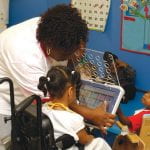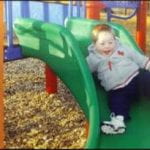Gormley and Light describe the experiences of 11 SLPs who work within the inpatient rehabilitation setting.
Improving Language and Communication Outcomes for Young Children with Complex Communication Needs
Many children with autism spectrum disorders, cerebral palsy, Down syndrome, and other special needs do not develop speech and language skills as expected; they may have limited speech, they may develop speech late, or they may have speech that is difficult to understand. Without access to speech, these children are severely restricted in the opportunities to express their needs and wants, participate in educational activities, and develop social relationships. There is solid research evidence that demonstrates that AAC offers positive benefits for young children with complex communication needs. Unfortunately most children with complex communication needs do not receive AAC intervention until they are much older and have already missed out on several important years of communication and language learning. The challenge is to investigate early AAC interventions to maximize the language and communication development of infants, toddlers and preschoolers with complex communication needs.
A series of research studies remains on-going to develop effective evidence-based AAC interventions to enhance the language and communication development of infants, toddlers and preschoolers with complex communication needs.
This research centers around two main components of AAC intervention:
• Designing AAC technologies /apps to better meet the needs and skills of young children with complex communication needs
• Teaching partners effective strategies to support the language and communication development of young children with complex communication needs.
We are committed to better understanding the design of AAC technologies /apps for infants, toddlers, and preschoolers, including research to
• Enhance the appeal of AAC technologies /apps for young children
• Decrease the learning demands of AAC technologies /apps for young children
• Increase the communication power of AAC technologies /apps for young children
• Decrease the time and effort required of parents and professionals to program AAC technologies /apps and implement them into the everyday lives of young children.
In addition we are involved in research to teach parents and professionals strategies to effectively support the communication and language development of young children with complex communication needs including strategies such as
• Identify appropriate contexts to support the communication of young children
• Provide the children with effective means to communicate including AAC systems such as signs, low tech symbols/boards, and high tech speech generating devices/ apps
• Select appropriate vocabulary for the children
• Set up the environment to support communication
• Use appropriate interaction strategies to support the children’s communication (e.g., provide lots of opportunities for communication, model use of AAC and speech, wait and allow time for communication, respond to the children’s communicative attempts, have fun)
Since 2014, the research and development projects with the RERC on AAC has been contributing insights into the visual-cognitive processing demands, and the impact of interactive video Visual Scene Displays (VSDs).
Overall, the PSU research supports effective evidence-based AAC intervention for infants, toddlers, and preschoolers with complex communication needs to enhance their language and communication development.
Hospitals as a language learning context for children with complex medical needs (Gormley et al., 2018)
At the 2018 ASHA Conference, Gormley and colleagues presented a case study of the language learning contexts observed during a hospital stay of a child with CCN.
A systematic review of language comprehension interventions for beginning communicators with ASD (Laubscher & Light, 2018)
At the 2018 ASHA Conference, Laubscher and Light reviewed the research on language comprehension interventions for individuals with ASD who are beginning communicators.
Designing evidence-based AAC systems for young children to enhance language & communication development — Presentation
This ASHA 2016 session shared results from many research studies to improve the design of AAC apps to increase appeal, reduce learning demands, and support language, literacy, and communication.
Supporting the language development of children wCCN: Just-in-Time programming of AAC apps — Presentation
Children who use AAC apps often do not have the vocabulary that they require within their daily interactions. At this ASHA 2016 presentation, the results of four research studies designed to investigate just-in-time (JIT) programming of vocabulary during interactions suggested directions to better support the language development of children with CCN.






